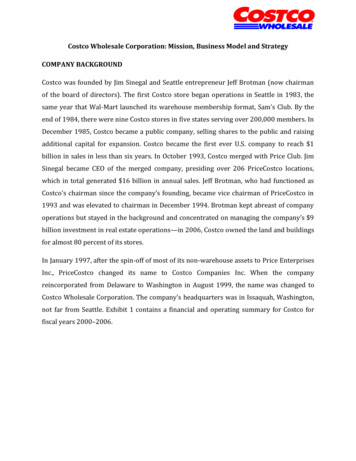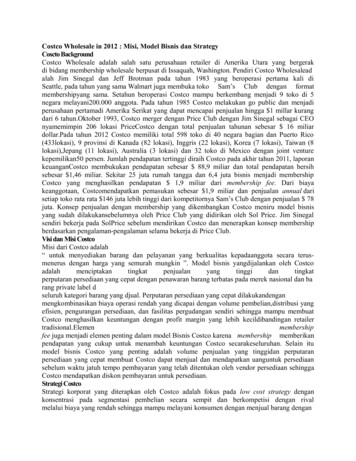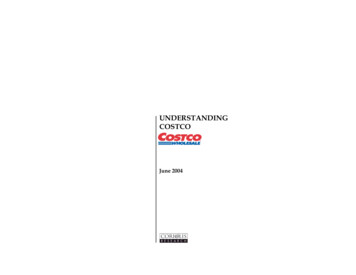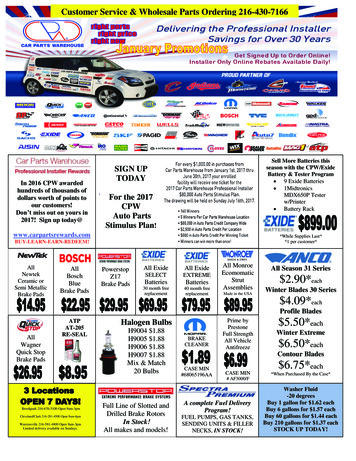
Transcription
COSTCO: Value at WholesaleSTOCK PRICE (5/2/2018): 194.00PRICE TARGET% UPSIDEBEAR114.0-41%RECOMMENDATION: BUYBASE222.1014%BULL250.029%Investment SummaryCostco, a leading global retail wholesaler, will continue its long track record of strong performanceand represents an attractive long opportunity for investors today. Despite the gloom surroundingtraditional bricks-and-mortar retailers over the disruptive impact of e-commerce, Costco will remainresilient and, over a 2-year time frame, I expect long investors to benefit from robust returns resultingfrom: Immense earnings stability provided by the company’s annual membership model. Strongcustomer loyalty enables pricing power and renewal traction into the foreseeable future. International expansion and China in particular should support margins and require only modestcapital outlays, though membership model may play less of a role. The advent of e-commerce platforms are more of an opportunity than a threat as the expandeddistribution channels and consolidation of market share towards larger players offsets thedisruption potential from new entrants such as Amazon.Market OverviewCostco operates in an industry that is highly competitive on price, merchandise quality and selection,convenience, distribution strategy, and customer service. In addition to other warehouse andsupercenter operators, Costco competes with global, national and regional wholesalers andtraditional retailers. These non-supercenter competitors include supermarkets, online retailers,department/specialty stores, among others. The company’s most significant competitors includeSam’s Club (Wal-Mart) and BJ’s Wholesale Club in the warehouse club segment as well as Target,Kroger, and Amazon.com with respect to general merchandise retail competitors.The warehouse clubs & supercenter space is a 460 billion market alone. Unlike more traditionalretail, these companies achieve cost savings byleveraging economies of scale through offeringproducts in bulk or charging membership fees paidby each customer (warehouse clubs). Walmart andCostco dominate this industry with Wal-Mart andCostco at 71.5% and 17.5% respectively.1
2Due to the low-cost, high-value products offered by warehouse clubs and supercenters, the industrytypically performs well regardless of the macroeconomic climate. However, when businesses andconsumers are healthier, they do visit these stores more frequently and spend more per visit.Despite solid overall industry growth, sharp declines in global crude oil prices over the last severalyears has been a headwind to revenue growth as many industry operators, including Costco, retailfuel at on-site gas stations. Despite this negative impact on top-line growth, the decline in oil had apositive impact on industry profit margins from lower transportation costs as these retail operatorstypically buy in bulk and source a substantial amount of goods from foreign manufacturers.Going forward, overall industry revenue should grow largely in line with the broader economy.Steadily rising disposable income levels as well as strong consumer confidence and corporate profitmargins will also be supportive. However, as with other retail segments, the industry faces a threatfrom increasing online competition as operators like Amazon continue to expand. Despite thisthreat, consumer demand remains high and should sustain expected growth.Company OverviewFounded in 1976, Costco operates as a wholesale retail club with a distinctive annual membershipmodel which sets it apart from other traditional retailers such as JC Penney and Target. Deriving itsrevenues from annual membership fees, Costco has been able to compete aggressively on price andhas become known for providing a variety of high quality, nationally available and private-labelmerchandise at the lowest prices available in the market. Sales take place either at one of Costco’s741 warehouse stores globally or online via Costco.com.Costco sells merchandise across 6 main categories: Foods (dry, packaged, groceries)Sundries (snacks, beverages, cleaning supplies)Hardlines (appliances, electronics, health, etc.)Fresh Foods (meat, produce, deli, bakery)Softlines (apparel, small appliances)Ancillary (gas stations, pharmacy)The company’s ancillary businesses provide expanded products and services that are designed toencourage members to visit its stores more frequently. At the end of FY2017, Costco operated 536gas stations. In addition, Costco has been significantly growing its online businesses in recent yearswhich offers customers additional products andservices even beyond what is available in itswarehouses. These operations include the ecommerce, business delivery, and travel segments,but at this point availability of each varies bycountry outside of the U.S. and Canada. Thecompany currently operates e-commerce websitesin all countries except Japan, Australia, Spain,Iceland, and France. As is evident, the company hasa truly global footprint with 227 of its 741 stores
3located outside the U.S. The countries with the largest presence outside of the U.S. are Canada (97),Mexico (37), the U.K. (28), Japan (26), Korea (13), and Taiwan (13). Overall, foreign operationsaccounted for 27% of FY2017 sales.Business StrategyCostcos’s strategy is to provide its members with a broad range of high-quality merchandise whileoffering prices that are consistently lower than its competitors. In order to accomplish this goal,Costco’s business model places an emphasis on large sales volumes, while costs are managed by bulkpurchasing, smart inventory practices, and private label branding.First and foremost, Costco’s no-frills warehouse format yields cost efficiencies through requiring bulkpurchasing. They limit items to fast-selling models, sizes, and colors and carry an average ofapproximately 3,800 SKUs per warehouse which is significantly less than other broadline retailers.Shoppers are able to capitalize on the bulk-buy discounts of retail, while Costco is better able toleverage volume pricing with suppliers.Costco also uses smart inventory practices to lower costs further. Costco employs a centralized huband-spoke delivery system between stores to reduce delivery costs. The warehouse-themed storesthemselves are also much easier and cheaper to stock and maintain than traditional store shelves.Costco’s limited product selection further reduce excess inventory and unsold goods, while thecompany’s strict controls of the entrances and exits help decrease leakage typical of other retailoperations.Costco has also invested significantly in the development of its private label brand, KirklandSignature. As a result, Kirkland has become known for their high quality at prices that are generallylower than those for similar national brand products. This has enabled the company to differentiateits merchandise offerings with the added benefit of further supporting higher margins.Thus, Costco is positioned to solve a key friction for retail consumers between the desire for highquality and an aversion to high costs. This model has proven to be highly popular with customers, whohave become renowned for their loyalty; annual renewal rates have averaged at 90% since 2010despite there being very few hurdles to cancellation and opt-in renewable program. This allows Costcoto weather cyclical downturns far more comfortably that traditional retailers and enabled the stockprice to rise at a rate consistently ahead of the S&P 500 index over the long run. That being said,conditions in the retail sector have forced Costco to raise membership fees in 2017 but this has not,as yet, sparked a material decline in renewal rates.Costco’s largest geographical market undoubtedly remains the United States although the companyhas an established history of international growth. Price Club, one of two companies that merged toform Costco in 1993, opened its first international warehouse in Mexico City in 1992. Since then, thefirm has opened operations in 9 other international markets and is currently looking to follow WalMart into the Chinese retail space.The most important driver of Costco’s profitability is sales growth, particularly growth in comparablesales (sales from warehouses open for more than one year). Comparable sales growth is achievedthrough two methods: increasing shopping frequency from new and existing members and
4secondarily the amount they spend on each visit. The company’s membership format and ability tocontrol costs are integral parts of its business model and are also significant drivers of financialperformance. Importantly, the company has managed to produce strong, steady improvementacross all key sales metrics over the past year and a half. In FY2017, net sales increased 9% to 126Bbillion, membership fee revenue rose 8% to 2.85 billion, and net income rose 14% to 2.68 billion.Investment Thesis 1: The Membership ProgramA majority of Costco’s new income comes from its membership fees. There is some market concernthat Costco’s membership fee pricing power may not sustain given newfound alternatives (AmazonPrime) and thus renewal rates could suffer. This concern stems from the fact that membershipgrowth is decelerating and the main driver for the current year’s EPS growth was due to a raise inmembership fees This concern is overstated for a few reasons.Costco’s membership program has enjoyed extreme levels of customer loyalty over the years,allowing the retailer to offer products at razor-thin margins and pass through price hikes withoutprotest (proven again this year). Not even the Great Recession could put a dent in Costco’smembership base. Costco’s renewal rates hover around 90%. Costco accomplishes this by sending its“cash back” rewards checks annually to member with their renewable forms. While the renewalprocess is opt-in, Costco doesn’t forget to reminder its customers the savings their membershipbrings.Costco earns their customer loyalty by actually delivering on its promise to deliver high qualityproducts at the best prices. Even as much of the retail industry struggles to compete with Amazon,Costco continues to remain price competitive, and Costco’s shoppers continue to shop offline totake advantage of these prices.Costco is also diversifying its revenue mix. While the membership fee continues to represent a largeportion of Costco’s earnings, this percentage has steadily decreased over time. This is in large partdue to Costco’s push toward its private label Kirkland brand. Due to its higher margins, Kirkland isincreasingly becoming a more important part of Costco’s profits. Further revenue expansion will berealized as Costco expands internationally.Investment Thesis 2: China as a Growth EngineThere is some market concern that Costco’s international expansion will be risky because ofdifferent consumer behavior, and geopolitical risk such as government intervention and FXexposure. This fear is unwarranted, though, due to Costco’s current success in China and thevastness of the Chinese market.China’s middle class is the largest in the world, and still growing. China’s upper middle class isexpected to make up 54% of urban private households by by the year 2022. This is an increase from14% in 2012. This is a great environment for Costco to capitalize on, as the upper middle class is itscore demographic in the U.S.
5Costco has already had limited success in China. Domestic retail giants have had mixed results inChina as they fail to embrace Chines shopping habits. Costco has already had successful pilotoperations in the country, though. In 2014, Costco opened up an online store on TMall Global. Salesgreatly exceeded expectations. Costco even set a Guiness World Record for tons of nuts shipped in aday in 2015. As of this year, Costco has expanded its partnership and opened an online presence onthe domestic version of TMall. Furthermore, Costco has announced plans to build a brick and mortarstore in Shanghai.Costco’s international margins are higher than its domestic business. Expansion in China willcertainly increase this effect. Chinese consumers have a higher willingness to pay for foreign goodsover domestic products. Costco already benefits from this pricing premium on their online Chinesestores. If Costco can just match Walmart’s presence in the country, Costco’s EPS could grow by12.9%.Investment Thesis 3: Is E-Commerce a Threat or an Opportunity?The market views that E-Commerce is a structural growth story that is both expanding the pie andstealing share from traditional brick-and-mortar. Costco’s customer base is thus similarly expected totransition towards online purchasing, threatening both the membership value proposition andcreating the opportunity for share losses. The major arguments can be classified into the following 3aspects:a. Costco vs. Amazon: The two companies attract consumers with similar behavior customers have proved willingness to pay a membership fee to gain access to bargainprices.b. Customer Demographic: The largest demographic group of Costco is 65 years old, whoprefer to shop in the traditional way. As years go by, an increasing number of consumersare likely to adopt e-commerce.c. Fears in Grocery Area: Competition from Amazon due to the acquisition of Whole FoodsMarket.Once again, I find the market’s concerns to be exaggerated.E-commerce is disrupting traditional brick-and-mortar retail, but COST stands to benefit from thetransition. The disruptive potential of e-commerce (and, more specifically, Amazon) is a commonacknowledgement in the market today. The incumbent retailers and their established brick-andmortar network of stores are the victims of a transition from spending in-person to spending online.While diminished prospects have weighed on the group’s valuations broadly, I believe the market haseffectively taken a risk-averse hatchet to multiples without regard to nuances that may supportspecific players, namely COST. As larger incumbents pivot towards their
Founded in 1976, Costco operates as a wholesale retail club with a distinctive annual membership model which sets it apart from other traditional retailers such as JC Penney and Target. Deriving its revenues from annual membership fees, Costco has been able to compete aggressively on price and











